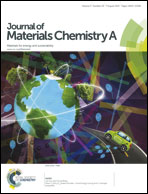Polymer functionalization to enhance interface quality of mixed matrix membranes for high CO2/CH4 gas separation
Abstract
Hydroxyl-functionalized homo- and co-polyimides 6FDA–(DAM)x–(HAB)y (with x : y molar ratio of 1 : 0; 2 : 1; 1 : 1; 1 : 2) and two metal–organic frameworks (MOFs), MIL-53(Al) and NH2-MIL-53(Al) were synthesized for preparation of mixed matrix membranes (MMMs). The MOF loadings were varied over the range of 10–20 wt% for NH2-MIL-53(Al) and 10–15 wt% for MIL-53(Al). The incorporation of hydroxyl groups into the polyimide backbone is expected to improve the interfacial interaction between the polymer matrix and fillers, consequently, enhancing gas separation performance of MMMs. A big increase in glass transition temperature (Tg) for MMMs confirmed the polymer chain rigidification, which was caused by a strong interaction between the hydroxyl groups in the copolyimides and the amine groups in NH2-MIL-53(Al). Additionally, SEM results showed that the hydroxyl groups facilitated the particle dispersion in the MMMs, either was NH2-MIL-53(Al) or MIL-53 used as filler. Gas separation performances of MMMs were characterized by both CO2/CH4 pure gas and binary permeation measurements at 35 °C and 150 psi. The incorporation of NH2-MIL-53(Al) in the hydroxyl-copolyimides was found to significantly improve the CO2/CH4 separation factor while maintaining CO2 permeability of the MMMs as high as those of the neat corresponding copolyimides, therefore greatly enhancing the MMM separation performance. For example, the MMM prepared from 6FDA–DAM–HAB (1 : 1) copolyimide and 10 wt% NH2-MIL-53(Al) showed a permeability/selectivity behavior approaching the 2008 Robeson's upper bound making it attractive for practical usage. The significant improvement in CO2/CH4 separation factor observed for the MMMs made of the hydroxyl-copolyimides and the amine-functionalized MOFs was due to (i) the enhanced polymer–filler compatibility originating from a mutual interaction between the polymer-functional moieties and the amine-functionalized MOF surface yielding defect-free MMMs and (ii) the high CO2/CH4 selective adsorption in the NH2-MIL-53(Al) framework.


 Please wait while we load your content...
Please wait while we load your content...